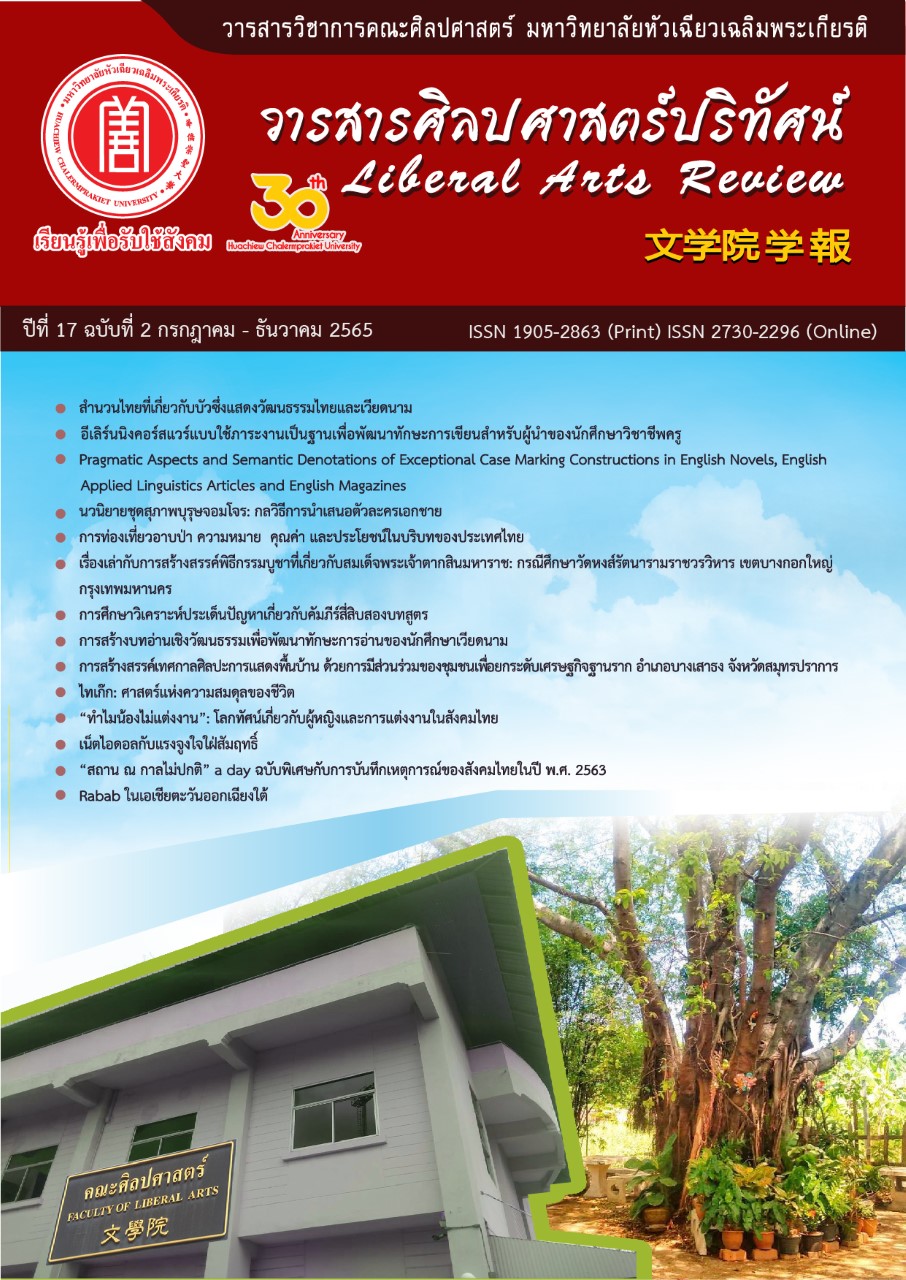Supab Burut Jomjone Novel Collection: Main Male Character Presentation Technique
DOI:
https://doi.org/10.14456/lar.2022.14Keywords:
Presentation Technique, Main Male Characters, Supab Burut JomjoneAbstract
This research article aims to examine the techniques used for presenting the main male characters in a novel collection titled Supab Burut Jomjone comprising 2 novels namely Duangjai Kabot and Maturos Lokan. This is a documentary research and descriptive analysis is used to present the results. Eight techniques were used to present the main male characters including 1) being twins (showing differences and similarities of the characters), 2) domestic and foreign settings (allowing the readers to learn the main male characters’ talent and love), 3) the use of legend or frame narrative (describing characteristics of the main male characters), 4) connection with historical story (showing the reasons behind the main male characters’ actions), 5) being personage (showing the main male characters’ appearance), 6) Kukri (symbolizing friendship of the main male characters), 7) the use of love songs (expressing the main male characters’ moods and emotions), and 8) symbolism (such as herbs, incantation, cabalistic sign tattoos, rituals, auspicious time, and talisman to show the main male characters’ locality). The results show that the techniques used for presenting 8 main male characters in Supaabburut Jom Jone are derived from the writer’s talent which allows him to select appropriate techniques to present the superior characteristics and unique gentleman’s qualifications of those characters. These outcomes reveal the combination f both the Thai and Western characteristics for the main male characters; also, this combination makes the story interesting and prominently helps the writer to show his perspective. Moreover, it provides a guideline for studying presentational techniques in other literary works in the future.
References
โกสินทร์ รตนประเสริฐ. (2555). สิ่งแรกในสยาม. กรุงเทพมหานคร: ยิปซี กรุ๊ป.
เขื่อนภูมิพล. (ม.ป.ป.). ประวัติเขื่อนภูมิพล. ค้นคืนจาก http://www.bhumiboldam.egat.com/index.php/2014-10-10-05-07-47/history.
ณารา. (2559). ดวงใจขบถ. กรุงเทพมหานคร: พิมพ์ดี.
ปิยธิดา คงวิมล และ วิมลมาศ ปฤชากุล. (2564). กลวิธีการใช้ภาษาเพื่อสื่ออุดมการณ์ผู้หญิงสมัยใหม่ในนิตยสารกุลสตรี. ศิลปศาสตร์ปริทัศน์, 16(2), 111-124.
วิทย์ ศิวะศริยานนท์. (2541). วรรณคดีและวรรณคดีวิจารณ์ (พิมพ์ครั้งที่ 5). กรุงเทพมหานคร: ธรรมชาติ.
สรณัฐ ไตลังคะ. (2560). ศาสตร์และศิลป์แห่งการเล่าเรื่อง (พิมพ์ครั้งที่ 3). กรุงเทพมหานคร: อมรินทร์พริ้นติ้ง แอนด์พับลิชชิ่ง.
สหะโรจน์ กิตติมหาเจริญ. (2551). “สุภาพบุรุษ” ในพระราชนิพนธ์ในพระบาทสมเด็จพระมงกุฎเกล้าเจ้าอยู่หัวกับวรรณกรรมศรีบูรพา (ดุษฎีนิพนธ์ปริญญาอักษรศาสตรดุษฎีบัณฑิต). จุฬาลงกรณ์มหาวิทยาลัย, กรุงเทพมหานคร.
สุรชาติ บำรุงสุข. (2545). สงครามอัฟกานิสถาน. กรุงเทพมหานคร: สถาบันวิถีทรรศน์.
สำนักงานราชบัณฑิตยสภา. (2561). พจนานุกรมศัพท์วรรณกรรม ฉบับราชบัณฑิตยสถาน (พิมพ์ครั้งที่ 2 แก้ไข เพิ่มเติม). กรุงเทพมหานคร: ราชบัณฑิตยสถาน.
หนังเก่า คลาสสิค รีวิวเวอร์. (ม.ป.ป.). Clark Gable – คลาร์ก เกเบิล. ค้นคืนจาก https://classicreviewer.wordpress.com/movie_people/clark-gable.
อุมาริการ์. (2560). มธุรสโลกันตร์ (พิมพ์ครั้งที่ 4). กรุงเทพมหานคร: พิมพ์ดี.
แฮนเซน, เจมส์ อาร์. (2561). First Man The Life of Neil A. Armstrong นีล อาร์มสตรอง ชายคนแรก ผู้เหยียบดวงจันทร์ (ภูษณิศา เขมะเสวี, แปล). กรุงเทพมหานคร: ยิปซี กรุ๊ป.
ดุสิตธานี. (ม.ป.ป.). ประวัติและพัฒนาการที่สำคัญ. ค้นคืนจาก https://www.dusit-international.com/th/about-us/our-heritage-and-milestones.
Griffith, K. (1994). Narrative Fiction: An Introduction and Antrology. Fort Worth: Hartcourt Brace College.
SPACETH.CO. (2019). Apollo 13 Missions Where Mistakes Are Not an Option. Retrieved from https://spaceth.co/apollo-13.
Downloads
Published
How to Cite
Issue
Section
License
Copyright (c) 2022 Liberal Arts Review

This work is licensed under a Creative Commons Attribution-NonCommercial-NoDerivatives 4.0 International License.
บทความที่ได้รับการตีพิมพ์เป็นลิขสิทธิ์ของวารสารศิลปศาสตร์วิชาการและวิจัย
ข้อความที่ปรากฏในบทความแต่ละเรื่องในวารสารวิชาการเล่มนี้เป็นความคิดเห็นส่วนตัวของผู้เขียนแต่ละท่านไม่เกี่ยวข้องกับมหาวิทยาลัยหัวเฉียวเฉลิมพระเกียรติ และคณาจารย์ท่านอื่นๆ ในมหาวิทยาลัยฯ แต่อย่างใด ความรับผิดชอบองค์ประกอบทั้งหมดของบทความแต่ละเรื่องเป็นของผู้เขียนแต่ละท่าน หากมีความผิดพลาดใดๆ ผู้เขียนแต่ละท่านจะรับผิดชอบบทความของตนเองแต่ผู้เดียว




